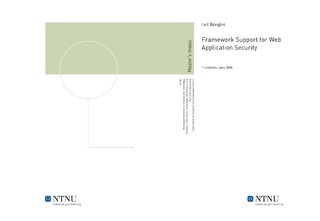| dc.contributor.advisor | Skramstad, Torbjørn | nb_NO |
| dc.contributor.advisor | Røstad, Lillian | nb_NO |
| dc.contributor.advisor | Oftedal, Erlend | nb_NO |
| dc.contributor.author | Ødegård, Leif | nb_NO |
| dc.date.accessioned | 2014-12-19T13:33:22Z | |
| dc.date.available | 2014-12-19T13:33:22Z | |
| dc.date.created | 2010-09-03 | nb_NO |
| dc.date.issued | 2006 | nb_NO |
| dc.identifier | 348181 | nb_NO |
| dc.identifier | ntnudaim:1127 | nb_NO |
| dc.identifier.uri | http://hdl.handle.net/11250/251076 | |
| dc.description.abstract | There are several good reasons to use a framework when you are developing a new web application. We often here that: *** frameworks use known patterns that result in an easily extendable architecture *** frameworks result in loose couplings between different modules in the application *** frameworks allow developer to concentrate on business logic instead of reinventing wheels that is already reinvented several times *** frameworks are often thoroughly tested and contains less bugs than custom solutions But security is rarely mentioned in this setting. Our main motivation in this thesis is therefore to discuss what three popular web application frameworks do to improve the overall security level. In this thesis we have chosen to research Spring, Struts and JSF. We use them to develop small applications and test whether they are vulnerable to different types of attacks or not. We focus on attacks involving metacharacters such that SQL-injection and cross-site scripting, but also security pitfalls connected to access control and error handling. We have found out that all three frameworks do implement some metacharacter handling. Since Spring tries to fill the role of a full-stack application framework, it provides some SQL metacharacter handling to avoid SQL-injections, but we have identified some implementation weaknesses that may lead to vulnerabilities. Cross-site scripting problems are handled in both Spring, Struts, and JSF by HTML-encoding as long as custom RenderKits are not introduced in JSF. When it comes to access control, the framework support is somewhat limited. They do support a role-based access control model, but this is not sufficient in applications where domain object access is connected to users rather than roles. To improve the access control in Struts applications, we provide an overall access control design that is based on aspect-oriented programming and integrates with standard Struts config files. Hopefully, this design is generic enough to suit several application's needs, but also useable to developers such that it results in a more secure access control containing less bugs than custom solutions. | nb_NO |
| dc.language | eng | nb_NO |
| dc.publisher | Institutt for datateknikk og informasjonsvitenskap | nb_NO |
| dc.subject | ntnudaim | no_NO |
| dc.subject | SIF2 datateknikk | no_NO |
| dc.subject | Intelligente systemer | no_NO |
| dc.title | Framework Support for Web Application Security | nb_NO |
| dc.type | Master thesis | nb_NO |
| dc.source.pagenumber | 110 | nb_NO |
| dc.contributor.department | Norges teknisk-naturvitenskapelige universitet, Fakultet for informasjonsteknologi, matematikk og elektroteknikk, Institutt for datateknikk og informasjonsvitenskap | nb_NO |

